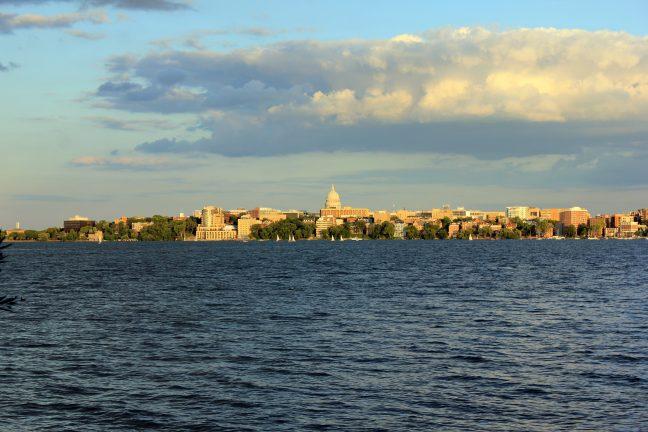Dane County recently approved reconstruction of the detention pond behind the East Towne Mall area, which will serve as a buffer for runoff. The wet pond, which is being referred to as East Towne Pond, is intended to limit the flow of excess liquid to Lake Monona.
The grant comes from the Urban Water Quality Grant Program, which aims to reduce the amount of contaminants entering area lakes. This can be done by replacing old stormwater outfalls, which transfer runoff directly to the lakes with better drainage options, Dane County Executive Joe Parisi said.
The East Towne Mall area was ranked within the top 10 sites eligible for reconstruction, based on the amount of sediment and phosphorus discharged into the lakes, and was eligible for a 75 percent reimbursement for the reconstruction, according to a statement.
“If they’re not in the top 10 list, they still contribute to the problem, so we want to replace those also,” Parisi said.
Those sites not in the top 10 list are eligible for a 50 percent reimbursement from the county up to $100,000. These reconstructions aim to replace earlier storm runoff systems, which can be found across Dane County, according to a statement.
There is a total of $1.3 million available through the grant program this year. The reconstruction of the East Towne Mall detention pond will cost $820,000, with the county covering its 75 percent reimbursement, equalling $615,000. The remaining $205,000 will come from the City of Madison, according to a statement.
UW Sea Grant Institute encourages lake sustainability across Wisconsin
“Our lakes are so critical to our entire economy and quality of life here, [so] it is vital that we do everything we can to keep them clean and make them even cleaner than they are now,” Parisi said.
Madison is uniquely situated between two freshwater lakes, which are subject to algae blooms — a result of excess nutrients in the water — which runoff frequently accumulates.
Parisi estimates the project will stop almost 200 pounds of phosphorus from entering nearby lakes, which is significant because one pound of phosphorus contains about 500 pounds of algae.
The lakes play a key role not only in the city of Madison but also the university.
Tori Kost, a freshman rower for the University of Wisconsin Varsity lightweight team, sees the lakes as a crucial part of the Wisconsin experience.
“Water, and especially Lake Mendota and Lake Monona, are a huge part of campus,” Kost said.
Though the rowing team still uses the lake when algae is present, it takes additional time for them to clean equipment. Because the team is frequently on the lake, they see the impacts of runoff firsthand, Kost said.
The university has many sustainability promoting campaigns across campus, such as recycling initiatives and energy conservation, but many of the efforts are land-based, Kost said.
Another issue Kost acknowledged is the broad range of students who come to UW, many of whom may not have experience with algae blooms or lake life in general.
“I don’t think they’re doing enough to promote the lakes and algae specifically,” Kost said.
Plant Dane program promotes cleaner lakes by making native plants increasingly accessible
UW rowing, Hoofers club and the sailing club are just a few groups whose specific purpose is water-based, while current students also enjoy the lakes recreationally, with the Terrace at Memorial Union being a popular spot during the warmer months.
UW’s situation near two lakes is also a feature that may help attract future students, like Dakota Roettger, an incoming freshman from northern Wisconsin.
“Growing up around bodies of water, I knew I wanted to go to school somewhere that would be close to the water,” Roettger said. “I know the effect that sustainable practices have on lakes.”
The lakes serve more than just students, said Ronnie Carda, a faculty associate in the UW kinesiology department. The Lakeshore Path is frequently used by runners like Carda.
While Lake Mendota is not going to be affected by the reconstruction of the East Towne Mall detention pond, the issues with algae are similar.
“When I run along lakeshore path, the path isn’t bad, but there are cutouts where you can get closer to the water, and I just don’t do those,” Carda said.
Carda emphasized the effect algae has on the water users of both Lake Monona and Mendota, calling its growth in the middle of the summer “traumatic.”
UW announces Go Big Read will explore ecological catastrophe in Great Lakes
The East Towne Pond is one initiative Madison is taking to clean the city’s two main bodies of water. While officials foresee a positive environmental impact, its construction will not have any negative effect on mall shoppers, Parisi said.
Parisi also stressed the conscientious use of products like lawn fertilizer, which — when not used in moderation — can contribute to runoff and lead to algae blooms because of their high phosphorus levels.
“Just know that anything that goes on the street ends up in our lakes,” Parisi said.

















